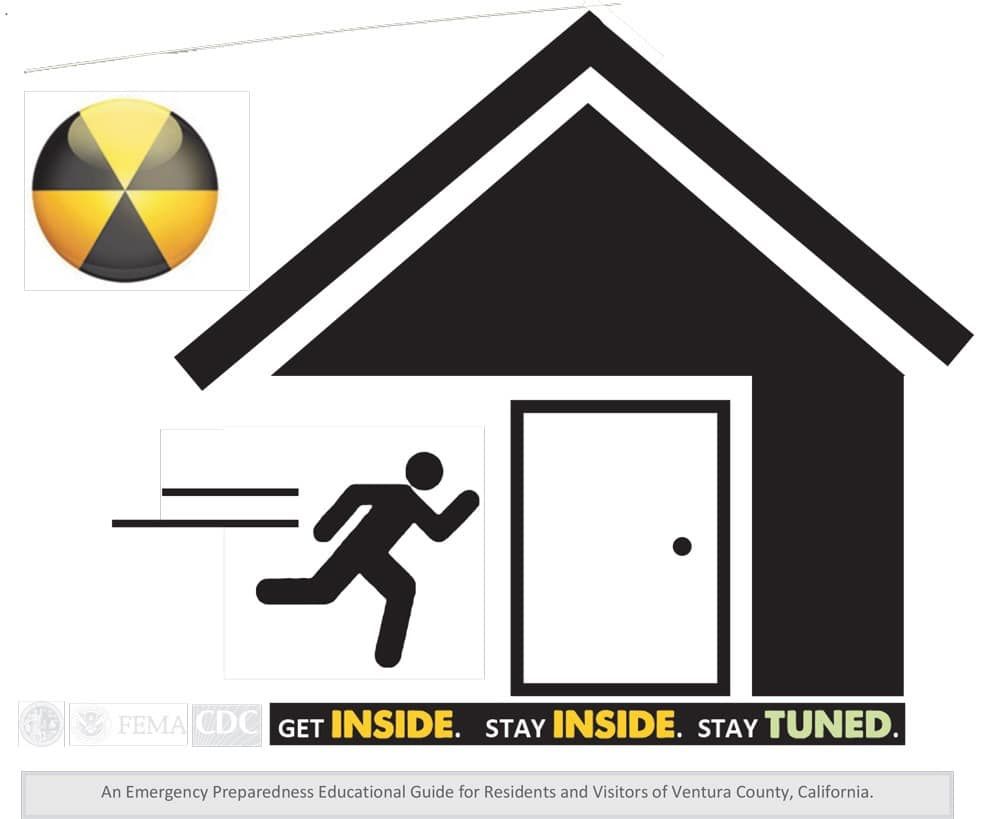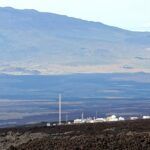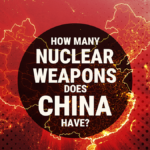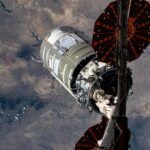This is not a drill: Lessons from the false Hawaiian missile alert
By Kristyn Karl, Ashley Lytle | January 10, 2019
 What to do in case of a nuclear strike or accident? Image courtesy of Ready Ventura County, FEMA, and CDC.
What to do in case of a nuclear strike or accident? Image courtesy of Ready Ventura County, FEMA, and CDC.
Thirty-eight minutes of sheer panic. That is what many Hawaiians experienced nearly one year ago when they received this startling alert: “BALLISTIC MISSILE THREAT INBOUND TO HAWAII. SEEK IMMEDIATE SHELTER. THIS IS NOT A DRILL.”
The alert was sent on January 13, 2018 in the midst of growing tensions between North Korea and the United States. A war of words had been building between US President Donald Trump and North Korean leader Kim Jong-un, during which North Korea threatened to strike Guam. In early January 2018, Kim Jong-un declared “The United States should know that the button for nuclear weapons is on my table.” And just a month earlier, Hawaii restarted monthly tests of their statewide warning siren system with a new tone to warn of an impending nuclear missile attack.
A few days after the Hawaiian alert, Japanese citizens received a similar false missile alert. Unlike Hawaii, however, there were no reports of panic or large disruptions as a result of the alert, despite occurring at a similarly tense time in the region.
Yet for citizens in Hawaii, panic and fear spread quickly, because many people were unsure of what to do in the face of an impending missile strike. Hawaiians reported calling 911 or searching the internet for information on how to respond in the event of a nuclear attack. In a real emergency, however, some lines of communication, including the internet and phone lines, may be down.
It may be easy to scoff in hindsight, or wonder what made Hawaii vulnerable to these fears while Japan seemed to handle a similar false alarm so well.
But imagine it happened to you.
Maybe you are at home after just finishing breakfast when an emergency alert gets pushed to your cell phone. Or perhaps you are driving to work or just sat down at your desk. An alert comes through that says there was a large explosion nearby which may include nuclear or radiological material. What would you do: Try to evacuate? Reunite with your family? Immediately seek shelter?
This is precisely what a recent study that we conducted sought to figure out by surveying two diverse samples of approximately 2,000 US citizens—in April 2018 and June 2018. The study sought to examine how important the topic of nuclear risk is to the American public; how much attention Americans give to it (if they thought about it at all); and how they say they would respond if a threat was imminent.
In April, a majority of Americans (64 percent) reported that they had not previously heard or seen any recommendations about what to do in the event of a nuclear attack. This is particularly striking since the false Hawaiian missile alert occurred only a few months prior, in January, and received widespread media coverage in the United States and around the globe.
More revealing is that most Americans also said that they do not think about what to do if a nuclear attack occurred. Whether it is a dirty bomb, an improvised nuclear device, or a conventional nuclear weapon, 23 percent of Americans reported putting “no effort at all” into “thinking about the possibility of a nuclear attack and how to prepare for it.” An additional 29 percent said they put “A little effort.”
Yet while research has been conducted around the world about the (mostly negative) public perceptions of anything nuclear-related, few studies have dealt directly with questions of nuclear emergency preparedness among citizens. Since the end of the Cold War and the decline of Civil Defense programs aimed at the public, many US citizens—although certainly not all—have seemingly lost track of the fact that they live in a world where nuclear detonations are possible.
When asked to estimate the likelihood that they would be affected by a nuclear attack in their lifetime, Americans reported in June 2018 that, on average, they thought it was slightly more unlikely than likely, but just below the level of a “toss up”—an event that is equally likely as unlikely. In other words, while Americans do not perceive a nuclear detonation as impossible or highly unlikely, they reported putting forth almost no effort to prepare for such an attack. This contrast between threat perception and preparation echoes similar trends found in research on Americans’ attitudes regarding nuclear risk from the mid-1950s through the 1980s.

Returning to the emergency alert situation, what did US citizens who were presented with this scenario say they would do first? When given choices, approximately 31 percent said they would “reunite with family as fast as possible” and nearly 30 percent reported that they would “go deep inside the nearest building.” Next, roughly 22 percent said they would “tune in for information from officials,” whereas only 12 percent reported they would “evacuate quickly” and 6 percent said they would “remove contaminated clothing and wash skin.”
On the whole, these statistics are somewhat reassuring. A majority of citizens would either seek shelter or wait for instructions from officials. Unfortunately, these responses could be misleading. If an attack was to occur and various forms of communication were down, citizens would not have a convenient list of possible options to choose from before acting.
That’s why prior to giving respondents this multiple-choice question about which action they would take, individuals were first asked: “After reading this alert, what would you immediately do?” Then, they could list any and all actions that came to mind.
Experts agree that there are very specific, concrete steps one can take in the aftermath of a nuclear attack to increase one’s chances of survival, summarized in the motto: “Get Inside, Stay Inside, Stay Tuned.” Developed by Ready Ventura County as part of a public health department venture in that California county, it has been adopted across many nuclear emergency preparedness initiatives in the United States, including FEMA, the Centers for Disease Control and Prevention, and Ready.gov.
Returning to what US citizens said they would do first (without a prepared list of options to select from), about 40 percent of individuals indicated that they would take an action that subsequently could be considered incorrect or wrong. If 40 percent of the public takes the wrong action in a real nuclear emergency, the so-called “preventable casualties” rate will be far too high.
Yet there is a silver lining. A 40-percent incorrect response rate means approximately 60 percent of the sample had said they would take an action that could be considered correct. Within this group, only 10 percent of the sample could be categorized as “Definitely correct.” These respondents were closest to the recommended advice from the disaster preparedness experts to “Get Inside, Stay Inside, Stay Tuned.” Therefore, 50 percent of the sample fell into the “mostly correct” categorization, which included responses such as “seek shelter.”
So, what factors improve citizens’ knowledge of what to do in the event of a nuclear attack?
Experimental evidence demonstrated that education about nuclear disaster preparedness is key to knowing what to do. Specifically, being exposed to the “Get Inside, Stay Inside, Stay Tuned” message, no matter what format the message took (e.g. televised news clip, printed article, infographic, or Public Service Announcement), significantly increased individuals’ stated intention to take the correct action and get deep inside the nearest building.
Statistically, age also mattered, as Americans 50 years and older were significantly more accurate in the actions they said they would take. And consistent with the experimental findings, accuracy also significantly improved among respondents who reported having heard recommendations about what to do previously, and among those who reported having heard about the false missile alert in Hawaii.
In other words, these research findings suggest that exposure to and awareness of public safety messages matters quite a bit.
In some ways, this is good news. Attention to preparedness messages can increase knowledge and influence how people intend to act. Unfortunately, winning the battle for citizens’ attention is difficult. In the two months from April to June between surveys, citizens reported talking to friends and family about nuclear topics significantly less, and a significantly lower proportion of citizens ranked nuclear threat as the most important current event. As the salience of Hawaii faded, so too did attention to the topic of nuclear risk.
With the one-year anniversary rapidly approaching, we should treat the Hawaiian incident as a cautionary tale. Despite the initial, often fatalistic, response to nuclear threat, there are clear steps one can take to greatly increase odds of survival: “Get Inside, Stay Inside, Stay Tuned.”
Importantly, research demonstrates that messaging can work if citizens pay attention to it. For a brief window of time, nuclear risk captured citizens’ attention because an unfortunate accident coincided with current events. Yet this was a missed opportunity for broad and consistent messaging. Better education on and preparedness for a possible nuclear attack is critical to improved safety and survival for citizens.
(Editor’s note: This research was funded by the Thompson Family Foundation.)
Together, we make the world safer.
The Bulletin elevates expert voices above the noise. But as an independent nonprofit organization, our operations depend on the support of readers like you. Help us continue to deliver quality journalism that holds leaders accountable. Your support of our work at any level is important. In return, we promise our coverage will be understandable, influential, vigilant, solution-oriented, and fair-minded. Together we can make a difference.
Keywords: nuclear alerts, nuclear education, nuclear weapons
Topics: Analysis, Nuclear Risk
















